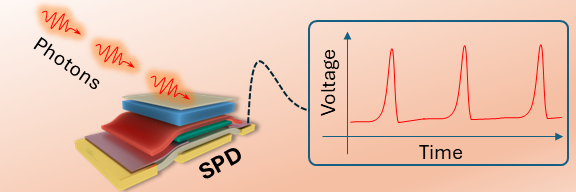Detecting single photons at room temperature

Schematic depicting streams of single photons being converted into measurable electrical signal by the single photon detector (SPD). Each photon detection event corresponds to a voltage pulse generated at the output.
A photon is a small energy packet of electromagnetic radiation. The amount of energy carried by a single photon around the optical fiber communication wavelength (~1,550 nm) is extremely tiny – on the order of 10–19 Joule – making reliable detection of individual photons highly challenging. Nevertheless, Single Photon Detectors (SPDs) play a crucial role in spectroscopy, astronomy, bioimaging, and sensing applications. SPDs are also integral parts of emerging quantum technologies, such as quantum computation and quantum communication. Photonic qubit is a promising platform for realising these quantum applications as they provide several advantages, such as room-temperature operation, long-range transmission, low de-coherence, and ease of manipulation.
SPDs that operate at room temperature are of particular interest as one can avoid the energy and cost overhead introduced by cryogenic cooling. Although silicon-based single photon avalanche diodes (SPADs) are well-matured and operate at room temperature, these devices cannot operate at the telecommunication wavelength (1,550 nm) and beyond. This is due to the relatively higher bandgap of silicon than the energy of the photon, which forbids absorption. InGaAs-based SPADs, on the other hand, are sensitive to 1,550 nm photons, but suffer from relatively lower efficiency, high dark count rate, after-pulsing probability, and pose hazards to the environment.
In a recent paper, a group of researchers led by Kausik Majumdar at the Department of Electrical Communication Engineering, demonstrate a room-temperature single-photon detector capable of operating at 1,550 nm using thin layered materials and their van der Waals heterojunction. They achieve this by coupling a low bandgap (≈ 350 meV) absorber to a sensitive van der Waals probe that is capable of detecting discrete electron fluctuation. The device exhibits an overall quantum efficiency of 21.4% for unpolarised light (estimated to reach 42.8% for polarised light), and a small dark count rate (<1 KHz) at room temperature. This work has the potential to impact several key quantum technology applications.
REFERENCE:
Abraham N, Watanabe K, Taniguchi T, Majumdar K, Room Temperature Single Photon Detection at 1550 nm using van der Waals Heterojunction, Advanced Functional Materials (2024).
https://onlinelibrary.wiley.com/doi/10.1002/adfm.202406510
LAB WEBSITE:
https://ece.iisc.ac.in/~kausikm/




